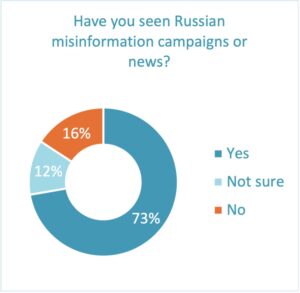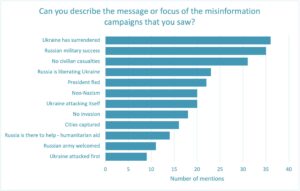- Contents
The Russian government’s misinformation campaign about the war in Ukraine started before the first shots were fired. Kremlin news sources initially denied plans to invade Ukraine, despite unprecedented military buildup along the border, then denied it was at war after the invasion began.
In the weeks to follow, Russian state media has continued to wage an information war online and across the airwaves to justify what it has described as a “special military operation” against its neighbor.
International journalists have been forced to flee areas under heavy bombardment as the war intensifies. Photographers for the Associated Press report being targeted by Russian forces in Mariupol before narrowly escaping with the assistance of Ukrainian soldiers. Without reports and photos of the devastation from independent journalists on the ground, disinformation fills the void.
Russian citizens have largely been cut off from private media and social media, including Facebook, Twitter, Instagram and TikTok. The Russian government, however, is leveraging those same platforms to disseminate disinformation outside the country.
In GeoPoll’s study in early March 2022 on the Russian Invasion of Ukraine, 73% of Ukrainians said they have seen the Russian government’s misinformation campaigns.
Those respondents were then asked to describe the misinformation campaigns they had seen. This post details the open-ended responses to that question.
Russian Misinformation Campaign Messages
The primary message or focus of the Russian misinformation campaigns described by respondents in Ukraine can be sorted into the following 12 themes. The numbers in the chart indicate how many times each theme was mentioned.

Respondents’ descriptions illustrate a concerted effort by the Russian government to distort reality and lower Ukrainian morale:
- Ukraine has surrendered: The most frequent message cited by respondents informs Ukrainian citizens that President Zelensky has surrendered and advises them to lay down their weapons.
- Russian military success: Respondents describe fabrications detailing the Russian military’s overwhelming victories on the battlefield, capturing all the major Ukrainian cities without suffering any losses of soldiers or equipment.
- No civilian casualties: Russian campaigns insist that the military is not bombing cities and has not caused any civilian casualties.
- Russia is liberating Ukraine: Russia justifies what it labels a “special military operation” as an effort to liberate and protect Ukraine from nationalists and Neo-Nazis.
- President fled: Despite President Zelensky’s frequent appearances on social media and the news, Russian campaigns claim he has fled Ukraine.
- Neo-Nazism: Russian media describes its adversary not as the country of Ukraine, but as Neo-Nazis, fascists, nationalists, Banderites, saboteurs, and drug addicts that have taken over the government.
- Ukraine attacking itself: Frequent messages claim that Ukraine is at war with itself and that the corrupt government is bombing its own cities and citizens.
- No invasion: Russia denies that it is at war or invading Ukraine (and forbids Russian media from using those terms), but instead is conducting a special military operation to liberate the people of Ukraine.
- Cities captured: Respondents describe reports from the battlefield that claim the capture and surrender of all major Ukrainian cities, including Kyiv, Kharkiv, and Kherson.
- Russia is there to help – humanitarian aid: The siege of Kherson is depicted in the Russian media as a humanitarian effort by Russian forces to distribute humanitarian aid and supplies.
- Russian army welcomed: Respondents describe a campaign showing Ukrainian citizens welcoming Russian soldiers with flowers and celebrations.
- Ukraine attacked first: As the war began, Russia media falsely claimed that Ukraine attacked first (in separatist regions), and Russia was forced to respond to the Ukrainian aggression.
Many of the misinformation campaigns described by respondents attempt to justify Russia’s invasion of Ukraine. Others try to confuse Ukrainian soldiers and citizens and undermine their will to fight.
So far, most of the Ukrainian respondents in our study recognize the Russian misinformation campaigns for what they are. As the information war intensifies and the bombardment of falsehoods continues, however, separating fact from fiction may become more difficult.
Interactive Data Dashboard
To dive deeper into GeoPoll’s data on the Russian invasion of Ukraine, click here to access the report and interactive dashboard. The dashboard provides responses to each question in the survey, filterable by region, age group, and gender.
Conduct Research in Ukraine
GeoPoll has extensive experience conducting research in vulnerable areas through remote mobile-based methodologies. In times when it is otherwise impossible to get information from people on the ground, remote data collection can play a pivotal role in capturing the sentiment and realities in hard-to-reach locations.
GeoPoll is continuing ongoing data collection in Ukraine to shed light on the situation and assist in the targeting of humanitarian relief.
To learn more about GeoPoll’s capabilities in Ukraine and around the world, please contact us.
